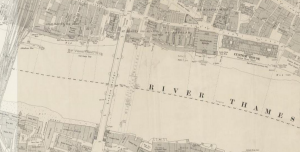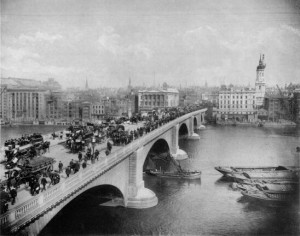
Using online resources such as the Charles Booth Online Archive and British Histories I was able to find out a few key characteristics about the historic road that is Chancery Lane. Chancery lane, located on the south end of Fleet Street, was once home of the Domus Conversorum. The Domus Conversum was the home and chapel of “forced” converted Jews around 1233. These Jews were forced to convert to Christianity at this time due to the terrible anti-semetic actions that were common in London at this point in time (Thornburry, Fleet Street).
As time passed on and the Domus Conversorum was broken up Chancery Lane became the home to London’s “inns of court”(Thornburry, Holborn). The “inns of court” are the four institutions where all lawyers are trained and are members of. Some included in the article specifically on Chancery Lane were the Lincoln’s Inn and the Gray’s Inn (Holborn).
Because of the roads location (west end of London) and the profession associated with the lane, it was considered a well off neighborhood.

According to the map above from the Charles Booth Archive, Chancery Lane was home to the middle-class and well to do of his time period. This was again due to it’s location in London and the predominant profession associated with that lane, Law.
In “A Lost Masterpiece” by George Egerton, Chancery Lane is where the narrator has been interrupted. The narrator at this point thinks they have an idea for a piece that would change the literary world forever. However when a fast paced woman is walking by their bus they are distracted by her and continue to blame the woman for making the narrator lose their track of thought. Knowing where this woman is walking, Chancery Lane, helps the reader really picture the woman. If the woman was on that street where the middle class stayed mostly, she would look the part. The narrator becomes obsessed as well with how fast she is moving, keeping up with their bus. This could one be a symbol of how fast paced the profession of Law is. The narrator also makes a direct connection with the history of the Lane as well;
“Is she a feminine presentment of the wandering Jew, a living
embodiment of the ghoul-like spirit that haunts the city and
murders fancy? (Egerton)”
The narrator knows about this dark time in the city of London and the horrific treatment of Jews back then. Maybe the narrator sees the sins of London, such as the treatment of Jews, keeping London from becoming as wonderful and bright as it could be. The woman or the “presentmant of the wandering Jew” is that sin come to life to interrupt London in it’s growth.
Egerton, George [Mary Chavelita Dunne Bright]. “A Lost Masterpiece.” The Yellow Book 1 (Apr. 1894): 189-96.The Yellow Nineties Online. Ed. Dennis Denisoff and Lorraine Janzen Kooistra. Ryerson University, 2010. Web. [Date of access]. http://www.1890s.ca/HTML.aspx?s=YBV1_egerton_masterpiece.html
Thornbury, Walter. ‘Fleet Street: Northern tributaries – Chancery Lane.’ Old and New London: Volume 1. London: Cassell, Petter & Galpin, 1878. 76-92. British History Online. Web. 10 September 2015. http://www.british-history.ac.uk/old-new-london/vol1/pp76-92.
Thornbury, Walter. ‘Holborn: Inns of Court and Chancery.’ Old and New London: Volume 2. London: Cassell, Petter & Galpin, 1878. 553-576. British History Online. Web. 10 September 2015. https://www.british-history.ac.uk/old-new-london/vol2/pp553-576.



